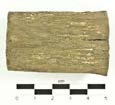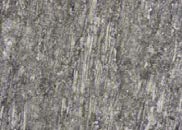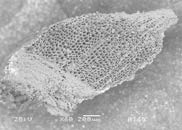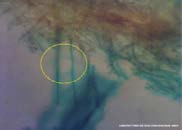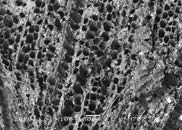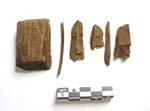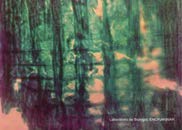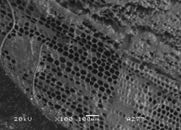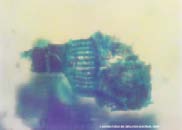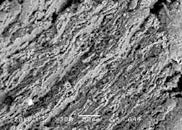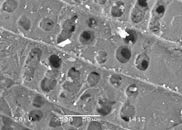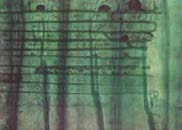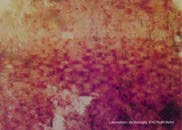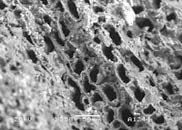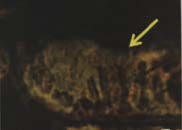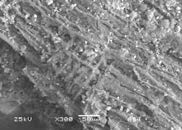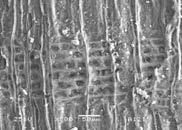Serviços Personalizados
Journal
Artigo
Indicadores
-
 Citado por SciELO
Citado por SciELO -
 Acessos
Acessos
Links relacionados
-
 Similares em
SciELO
Similares em
SciELO
Compartilhar
Intervención (México DF)
versão impressa ISSN 2007-249X
Intervención (Méx. DF) vol.12 no.24 México Jul./Dez. 2021 Epub 26-Set-2022
https://doi.org/10.30763/intervencion.258.v2n24.37.2021
Academic report
Taxonomic Identification of Wooden Objects Recovered in the Proyecto Templo Mayor, Mexico
*Proyecto Templo Mayor-Museo del Templo Mayor (PTM-MTM), Instituto Nacional de Antropología e Historia (INAH), México. mariabarajas35@yahoo.com.mx
**Escuela Nacional de Conservación, Restauración y Museografía (ENCRyM), Instituto Nacional de Antropología e Historia (INAH), México. lpaty_oc@hotmail.com
***Escuela Nacional de Conservación, Restauración y Museografía (ENCRyM), Instituto Nacional de Antropología e Historia (INAH), México. gabrielacruzchagoyan@gmail.com
****Escuela Nacional de Conservación, Restauración y Museografía (ENCRyM), Instituto Nacional de Antropología e Historia (INAH), México. irais.vf@gmail.com
*****Proyecto Templo Mayor-Museo del Templo Mayor (PTM-MTM), Instituto Nacional de Antropología e Historia (INAH), México. asanromanp@gmail.com
This study provides a multidisciplinary overview of the identification of wood species used in objects found in the Templo Mayor, Mexico. With the aim of understanding both the state of conservation and the stabilization process carried out on the collection -which to date comprises over 2 500 elements- the information on taxonomic identifications thus obtained provides aspects enabling us to comprehensively understand these objects.
This research is part of the first phase of an on-going work and presents the results obtained from 62 samples which were selected and analyzed according to the objects’ place of origin, their state of conservation and the typologies established as part of their archaeological analysis.
Key words: Templo Mayor; taxonomic identification; gymnosperm; angiosperm; synthetic sugars
Este estudio ofrece una mirada multidisciplinaria sobre la identificación de las especies de madera que se utilizaron en la manufactura de los objetos recuperados en el Proyecto Templo Mayor (PTM), México. Con el fin de comprender tanto el estado de conservación como el proceso de estabilización realizado a una colección que hasta el momento se conforma por más de 2 500 elementos, la información obtenida de las identificaciones taxonómicas aborda aspectos que permiten profundizar integralmente en el conocimiento de esos objetos.
La presente investigación forma parte de una primera etapa de trabajo que continúa en curso, y expone los resultados obtenidos en 62 muestras que se seleccionaron y analizaron de acuerdo con la procedencia de los objetos, su estado de conservación y las tipologías que se han establecido como resultado de su análisis arqueológico.
Palabras clave: Templo Mayor; identificación taxonómica; gimnosperma; angiosperma; azúcares sintéticos
Introduction
The hugely significant discovery of the monumental sculpture of goddess Tlaltecuhtli, located precisely at the foot of Tenochtitlan’s Templo Mayor (main temple), led to the launching of a long-term scientific program in May 2007. Ever since, the team of specialists who form part of the Proyecto Templo Mayor (PTM, Mexico), headed by archaeologist Leonardo López Luján, has focused on exploring this site, in which over 60 ritual deposits have been found to date.
The study and analysis of these deposits has resulted in researchers being able to recover and preserve tens of thousands of objects of different sorts, made from mineral, botanical, faunistic and human remains, as well as numerous cultural objects produced with assorted raw materials. These results not only reveal the great religious significance of the area where the monolith was found, but also the undeniable political and economic power of the Mexica Empire (López, 2014, p. 77).
Some of the offerings (ofrendas) were found to include numerous artifacts made of wood, whose conservation and permanence is considered exceptional because, due to its organic nature, they were subjected to conditions of great vulnerability owing to various factors in their surroundings (Unger et al., 2001, p. 23-25). Over more than a decade of work in this area, the joint endeavors of PTM restorers and archaeologists have produced important results. The specific contextual conditions of the Historic Centre of Mexico City, combined with the tasks aimed at recovering, stabilizing and studying the objects, now foster an examination of different aspects related to this important collection.
For the present research, which is still in progress, specific objectives have been set, the most noteworthy being to determine the wood species used to produce these objects and their possible link to the effects of deterioration, along with conclusions emanating from their stabilization. This led to collaboration with the Laboratorio de Biología (biology laboratory) at the Escuela Nacional de Conservación, Restauración y Museografía (ENCRyM, Mexico), with which a research protocol was established concerning the taxonomical identification of the wood. This paper presents and reviews the results obtained hitherto, which consist of the study and analysis of 62 samples selected according to which offerings the objects came from, their state of conservation and the typologies established through archaeological analysis.
The collection’s state of conservation
Whenever wooden remains are discovered in the ptm, the restorers participate with archaeologists continuously and in parallel, in order to monitor and control their in situ contextual conditions. As a result, and with the subsequent implementation of tasks aimed at stabilizing and analyzing these wooden objects, there now exists a general diagnosis of the state of conservation of this collection, which to date consists of over 2 500 elements. Since it is quite vast and is constantly growing, one of this research’s key objectives is to complement, substantiate and collate the general diagnostic results with those derived from the taxonomical identifications.
When speaking of the mechanisms and effects of deterioration it must be noted that the process of alteration in the vegetal structures of the wood can be caused by three different factors: chemical, physical or biological (Alonso, 1996, p. 55-98). Chemical deterioration is mainly due to the continued presence of humidity during the time the object was underground. Although this circumstance contributes towards the object’s conservation, at the same time it weakens the vegetal structures by breaking up its main components: structurally, the cell walls are swollen, producing a decline in its mechanical properties, while the objects display modifications of their physical characteristics, that is to say, weight, color, and permeability, to the naked eye. Moreover, those objects are extremely fragile and soft to the touch, hence they must be manipulated with the utmost care.
It can be said that this physical deterioration is related to the chemical one, since in many cases the hydrolyzed structures pre sent deformations, cracks or fractures, as well as partial or total loss. Dimensional and morphological changes have also been observed in some of the objects, which probably caused various surfaces to lose their layer of decoration. Though biological deterioration has been observed sporadically, it is the least common in relation to the collection as a whole, and is very likely due to the anaerobic conditions of their contexts. Nonetheless, evidence of biological attack has been registered on certain occasions: the presence of mycelium (hyphae in the cellular tissue) as well as stains and galleries caused by xylophagous insects (Figure 1).

(Photos: Alejandra Alonso & Néstor Santiago, 2009-2010; courtesy: Proyecto Templo Mayor-Instituto Nacional de Antropología e Historia [PTM-INAH], Mexico)
Figure 1 Example of the effects of deterioration on objects: 1. chemical, 2. physical and 3. biological.
Lastly, in accordance with analysis of the state of conservation presented by thousands of wooden objects, it has been observed that those found within boxes or coffers made of tezontle ashlars were imbedded in a series of specific conditions that hindered the process of transformation of their constituent materials. The atmospheric conditions in these cases remained stable so long as the objects were underground. Not only were a greater quantity of wooden objects recovered from these deposits, but they were also complete or almost complete and many even preserved traces of polychromy on their surfaces.
On this topic, it is worth mentioning that the type of receptacle or container in which objects were deposited greatly determined their conservation. In the Templo Mayor these can be of three types: offerings where the objects were placed directly in infills, usually on a bed of sand; offerings in boxes of stone ashlars with slabs for covers, and lastly, offerings in carved stone urns (López, 1993, p. 124-130).
The analysis of all these features is complemented by the data obtained from the taxonomic identifications, because we seek to determine possible relationships between the species and their propensity to deteriorate. Up to now, the joint and comprehensive assessment of this collection enables us to consider that wooden objects contained in ashlar boxes placed at a greater depth had the most stable conditions while they were buried, hence they thwarted some of the transformation processes. Thus, the cases in which those objects were best preserved were: Ofrenda 141, Ofrenda 126, Ofrenda 125, Ofrenda 136 and finally, Ofrenda 120.
Albeit every offering is considered unique and relevant as a whole, a large number and a great variety of materials associated with one another were found within each. The fact that the Templo Mayor offerings consist of many interrelated materials -with each case having a specific purpose in the ritual act they formed part of (López, 1993, p. 109) -, leads us to believe that the direct interaction between those contained within could have been a factor that promoted or affected the preservation of certain wooden objects. Moreover, those five deposits all had covers of stone slabs with mortar and lime, which created a sort of seal that perhaps contributed to contextual conditions inside being more controlled (Figure 2).
Stabilization processes for the wooden objects
For almost 50 years, various methods have existed and different substances used in the field of conservation, in order to provide stability to archaeological wood from damp contexts. Nowadays, specialists strive to use compounds that are stable and, when possible, compatible with the vegetal structures (Alonso, 2011, p. 60). In this context, the different experiences derived from using polyethylene glycol and synthetic sugars can be mentioned.
Polyethylene glycol is a synthetic material, commonly known as PEG. Its molecular structure is characterized by a large number of ether bonds and two groups of hydroxyl terminals which can rapidly form hydrogen bonds with the cellulose (Sánchez et al., 2017, p. 10). Its usage to preserve wood derives from its application in anti-contraction treatments for fresh wood since the middle of last century. The procedure consists of substituting the water inside the wood for PEG (Sierra, 2003, p. 249).
On the other hand, for a little over 30 years sugars have been used as an alternative to PEG. Like cellulose, they are natural polymers formed of carbohydrate chains, hence their composition makes them chemically and physically akin to wood. One of their great advantages is being minimally hygroscopic and neither toxic nor corrosive; another benefit is that nowadays using them is low-cost (Morgos et al., 2015, p. 15).
Sucrose (galactose + fructose) is among the most frequently used sugars to stabilize damp wood; it was first applied in Italy at the beginning of the 70s. Later on, in the 90s, they began to work with lactitol monohydrate, a low molecular weight sweetener which is highly soluble in water. The method of stabilization with lactitol has since been studied and perfected by the researchers Andras Morgos and Setsuo Imazu (Morgos et al., 2008, p. 1074-1081; Morgos et al., 2015, p. 15-21; Barajas et al., 2019, p. 339-362; Sánchez et al., 2017, p. 5-21). This method was pioneered in Mexico in 2002 by restorer Alejandra Alonso, who carried out the stabilization of wooden artifacts from Templo Mayor Ofrenda 102 (Alonso et al., 2002). More recently, various studies and treatments have been implemented using this sweetener combined with trehalose dihydrate. The latter has a greater degree of solubility compared with lactitol and contributes with an adequate crystallization (Morgos et al., 2008, p. 1079; Morgos et al., 2015, p. 17).
The PTM has used lactitol alone to stabilize wooden objects and, subsequently, in combination with trehalose. The process to substitute or infiltrate the wood is performed gradually, and the concentration of the dilution increases progressively until the desired maximum is reached. In the case of the collection at hand, the infiltration began with a 5% concentration, increasing little by little up to 82%. The gradual increase in the solution’s percentage is performed over 13 stages, defined by monitoring the increase in weight during the infiltration of the most representative artifacts. This has meant that the procedure takes between nine and twelve months in all.
Based on these references, and as a result of the stabilization work on the collection, the PTM-recommended methodologies are continually revised, since these must sometimes be adapted to specific cases, according to timeframes and the availability of materials for the intervention, as well as to advance studies on this topic. During the first years of work (2008-2011) only lactitol monohydrate was used. In accordance with evolution in research, as of mid-2011 the PTM has worked with the addition of 10% trehalose to the original sweetener solution.
Once the wooden objects have been stabilized, and as a result of their preliminary analysis, they are catalogued according to their use, form and symbolism. The collection consists of: darts, spear-throwers, breastplates, earrings, masks, ornaments, ear flares (orejeras), scepters, Tlaloc jugs, headdresses, one representation of a flower and another of a bone (V. E. Cortés Meléndez, personal communication, February 2021). The specific analysis and the link between the different wooden objects being studied and the other gifts within each offering will enable us to establish their symbolism more accurately (Figure 3).
Theoretical justification: taxonomic identification of the collection and initial assessments
According to the archaeological analysis of the objects, and taking into account their overall state of conservation, the PTM researchers and specialists in the ENCRyM biology laboratory are currently working on the taxonomic identification of the most representative elements. It should be noted that, in the field of archaeology and conservation, important works concerning the anatomical study of wood have been carried out (Montúfar, 1999; López et al., 2003; Alonso et al., 2002; Alonso, & Tran, 2010; Cruz, 2015), whose results provide interdisciplinary approaches that contribute to comprehensive knowledge about cultural heritage items made of this raw material.
Given that wood is composed of a series of xylem tissues, composed of numerous specialized cells that perform functions such as transporting sap and transforming and storing vital products, its structure is highly heterogenous. Therefore, scientific studies analyze both the macroscopic and microscopic levels of the three planes, or sections, of these structures: the transversal plane (Tr), longitudinal tangential plane (Lt) and the longitudinal radial plane (Lr) (García et al., 2003, p. 15-16).
From the identifications, and as part of the first phase of this research, the information was supplemented with details on the type of vegetation (Comisión Nacional para el Conocimiento y Uso de la Biodiversidad [Conabio], 2020; Rzedowski, 2006) and density values for each species, since both have an impact on their physical-mechanical characteristics (Boding, & Jane, in Sotomayor, 2005, p. 6). Perhaps this will enable us to answer, from the archaeological analysis, certain questions regarding the degree to which the identified species can easily be related with the objects produced, as well as with the established typologies.
Likewise, we consider that data obtained from this study could contribute towards obtaining a precise diagnostic that establishes with greater clarity the possible correspondence between the chosen species and mechanisms of deterioration. These assessments will also enable us to evaluate the results on the process of stabilization with synthetic sugars. All these aspects are still being analyzed as part of the current, and ensuing, phases of our research.
Furthermore, it is believed that the results of taxonomic identification will make it possible to collate and complement information provided by historical sources. Hence, this multidisciplinary research acquires great relevance by offering the opportunity to carry out critical reviews on the main documents on this subject, as part of the collection’s archaeological analysis. Herein it is worth noting that friar Bernardino de Sahagún mentions in his accounts that during the Mexica era the carpenters and carvers were skilled artisans who made use of the trees and plants available in the Valley of Mexico (Sahagún, 1979, lib. XI, ff. 119-120). The research’s initial results enable us to confirm that, exactly as sources purport, this material resource was widely used for a large number of productive activities, due to its characteristics. During the Mexica period wood was mostly extracted from the cold and temperate forests near the Valley, and these species must have been chosen according to their required use (López et al., 2003, p. 153) (Figure 4).

(Source: Sahagún, 1979, lib. XI, ff. 112-117)
Figure 4 Florentine Codex. Tree species in the Valley of Mexico.
Methodological design
For the study of the first set of samples, we took into account that they would have to be processed beforehand, and also considered that they were mostly taken from objects stabilized with synthetic sugars. This fact was important because during the course of our research we confirmed that stabilization by means of substitution does allow samples to be taken and processed in the laboratory, as well as the analysis o wooden objects already impregnated with synthetic sugars.
Following the criterion on the number of wood elements recovered in each of the offerings, their state of conservation and the representativity of typologies established through archaeological analysis, the first phase of this research studied and analyzed 62 samples, which were selected according to the offerings from which the objects emanated and, although this might seem redundant, their state of conservation and established typologies.
The offerings or operations from which the samples originated are: Operation 6 (1 element), Ofrenda 120 (1 element), Ofrenda 125 (4 elements), Ofrenda 126 (10 elements), Ofrenda 130 (1 element), Ofrenda 136 (2 elements), Ofrenda 137 (7 elements), Ofrenda 141 (24 elements), Ofrenda 163 (1 element), Ofrenda 174 (8 elements) and Ofrenda 176 (3 elements). It is noteworthy that although each of those deposits is considered unique and relevant, in certain cases the direct interaction between the various elements it contained could have been a factor that fostered or affected the conservation of the wooden objects. Hence the importance of knowing the different species used when manufacturing these objects. The results obtained in this and subsequent phases of this work will allow us to complement and collate the relationships that exist between constituent materials, the frequency of their presence in the diverse offerings, their state of conservation and the established typologies (Figure 5).

(Illustration: Michelle de Anda Rogel, 2021; courtesy: PTM-INAH, Mexico)
Figure 5 Location of the offerings from which analyzed samples originated.
In each case a minimal sample of material (approximately 3 mm) was taken, to which manual histological cuts (thin slices) were made on the transversal (Tr), longitudinal tangential (Lt) and/or longitudinal radial (Lr) planes or sections (García et al., 2003, p. 15-16), with the aim of observing both their macroscopic and microscopic structures. The samples were then dyed with iodine-green and fixed with Canada balsam (a natural resin), to obtain the fixed microscope preparations (Sandoval, 2005, p. 48). The number of cuts or slices depended on the conditions of each sample and the concentration of synthetic sugars. It is import to highlight that for certain samples, only one or two slides of planes could be obtained.
Each fixed preparation was observed by optical microscopy with a Leica GZ6 stereoscopic microscope and a Zeiss ICS Standard 25 optical microscope. A micro-photographical register was also taken with a Nikon Coolpix S1800 digital camera. In all cases, the anatomical vegetal elements observed were described for each plane, for assessment.
The taxonomic identification of the samples was performed by means of observing the anatomical elements as well as by reviewing taxonomic keys and specialized bibliography (IAWA Committee, 1989 De la Pazet al., 1982; Sánchez-González, 2008). Likewise, the xylarium (repository of Mexican wood plaques) at the ENCRyM was consulted as reference material for the anatomical description.
The results obtained in this first phase were also supplemented with the density values for each step. This was done in order to understand if said feature could be related to the physical-mechanical properties and, therefore, the ease or complexity with which the objects were made.
To complement these analyses, observations of the samples were also made under high- and low-vacuum scanning electron microscope (SEM), with a JEOL JSM-6460LV scanning electron microscope, in the Subdirección de Laboratorios y Apoyo Académico of the Instituto Nacional de Antropología e Historia (INAH). This enabled us to integrate and, in some cases, corroborate the observations of the anatomical elements in the process of taxonomic identification. Furthermore, in the SEM studies the first assessments to evaluate the method of substitution by synthetic sugars were made.
Results obtained from the first set of samples
Wood species are divided into gymnosperms (conifers), called “plants lacking flowers with seeds” (from the Greek gymnos, ‘naked’, and sperma, ‘seed’), and angiosperms that have flowers and seeds (from the Greek angion, ‘receptacle’, and sperma, ‘seed’), which once mature become a fruit (Nabors, 2006, p. 17). Of the 62 samples identified taxonomically, it was possible to determine four genera and one species belonging to the Pinaceae family with the genera Pinus sp. (pine) and Abies sp. (fir) as well as from the Cupressaceae family with the genera Taxodium sp. (Montezuma cypress) and Cupressus sp. (cypress).
On the other hand, a smaller percentage of results involved wood identified as angiosperm, registering the Betuleceae family with the genus Alnus sp. (alder) and the Scrophulariaceae family with the genus Buddleja sp. (butterfly bush).
Anatomical description and density values of the genus identified
Pine, ayacahuite (Mexican white pine)
The anatomical elements observed in the samples of the genus Pinus sp. corresponded to: from a transversal view, the presence of tracheids forming growth rings and resiniferous canals; from a tangential view, tracheids, uniseriate and fusiform rays, whilst from a radial view, cross-field of pinoid-type pitting as well as smooth-bordered ray tracheids. Particularly, in the only species determined as Pinus ayacahuite, a cross-field of one or two pits per fenestroid-type window, ray tracheids with smooth-bordered pits and uniseriate bordered pits were observed.
Fir or oyamel
The anatomical elements observed from a longitudinal view corresponded to uniseriate rays, longitudinal tracheids with bordered pits arranged in uni- and biseriate rows, and the presence of Sanio’s bars; from a radial view, taxodioid cross-field pitting of one or two windows and a row of bordered pits.
Cypress
The sample analyzed did not present resiniferous canals of any kind. The transverse section revealed a growth ring barely marked by four or five rows of tracheids of late wood; from a tangential cut, a row of bordered pits, and from the radial cut, cupressoid cross-field pitting.
Montezuma cypress or ahuehuete
The presence of: on the longitudinal sections, spiral thickenings and a row of bordered pits and homogenous and uniseriate rays, and, from a radial view, taxodioid cross-field pitting of one to four per window, were observed in these samples.
Alder or aile
The elements seen on the longitudinal cuts are vessels with scalariform perforated plaques (plates); the presence of vessel-ray pits similar to those of the vessels and libriform fibers and uniseriate rays.
Butterfly bush or tepozán
The anatomical elements observed on Buddleja sp.: from a transversal view, solitary pores; from a tangential view, polyseriate rays and the presence of fibers; from a radial view helicoidal thickening spanning the vessel, with simple perforated plaque (plate) (Figure 6 and 7).
Figure 6 Anatomical elements observed in the samples.
| Type cells | Plans or cuts |
|---|---|
| Gymnosperm (Conifer) | |
|
Tracheids In cross section, they make up early wood and late wood. In longitudinal view they are connected to each other at the cell wall by areolate scores. ㅤ Parenchymal cells They are seen in cross section as epithelial cells of the resin canals. In tangential cut they are interconnected with each other by simple punctuations. Depending on the position of the tree, they are observed as longitudinal parenchyma (vertical or axial) and radial parenchyma (radiums or rays). In radial section, the crossover field is generated by the union of tracheids with spokes. |
Cross cut (10x) ㅤ Tangential cut (10x) ㅤ Radial cut (40x) |
| Angiosperm | |
|
Vessels In cross section they are called pores. In longitudinal section, vessel elements (scores) are observed. ㅤ Libriform fibers Longitudinal views with elongated shape and presence of a lumen. ㅤ Tracheids Intermediate position between vessels and libriform fibers. ㅤ Parenchymal cells Prismatic cells, make up the rays or radii. Longitudinal and horizontal parenchyma. |
Cross cut (10x) ㅤ Tangential cut (10x) ㅤ Radial cut (40x) |
(Chart: Conservation Team of the Proyecto Templo Mayor, Biology Lab [ENCRyM] and Sub-directorate of Laboratories and Academic Support [INAH], 2021; courtesy: PTM-INAH)
Figure 7 Chart of results for the first group of samples.
| Operation Ofrenda | Description | Optical Microscopy (OM) | Scanning Electron Microscopy (SEM) | Taxonomic Identification |
|---|---|---|---|---|
| OP 6 |
Indeterminada MO 158 |
40x |
100x |
Gimnosperma Familia: Pinaceae Género: posible Abies Kunth. Schltdl. et Chan |
| OF 120 |
Corteza A 908 |
10x |
400x |
Gimnosperma |
| OF 125 |
Orejera-tapa A 668 |
40x |
Sin registro meb | Gimnosperma Familia: Curessaceae Género: posible Taxodium Ten. |
| OF 125 |
Orejera-poste A 674 |
40x |
Sin registro meb | Gimnosperma Familia: Curessaceae Género: posible Taxodium Ten. |
| OF 125 |
Orejera-cilindro A 685 |
40x |
500x |
Gimnosperma Familia: Curessaceae Género: posible Taxodium Ten. |
| OF 125 |
Orejera-cilindro A 600 |
10x |
150x |
Gimnosperma Familia: Curessaceae Género: posible Taxodium Ten. |
| OF 126 |
Cetro Xiuhcóatl A 169 |
40x |
100x |
Gimnosperma Familia: Pinaceae Género: Pinus L. |
| OF 126 |
Átlatl A 383 |
10x |
60x |
Gimnosperma Familia: Pinaceae Género: Pinus L. |
| OF 126 |
Moño A 336 |
40x |
500x |
Gimnosperma Familia: Pinaceae Género: Pinus L. |
| OF 126 |
Máscara Tláloc A 192 |
40x |
250x |
Gimnosperma Familia: Pinaceae Género: Pinus L. |
| OF 126 |
Jarra Tláloc A 214 |
40x |
500x |
Gimnosperma Familia: Pinaceae Género: Pinus L. |
| OF 126 |
Cetro Xiuhcóatl A 173 |
40x |
500x |
Gimnosperma Familia: Pinaceae Género: Pinus L. |
| OF 126 |
Xiuhtótotl A 228 |
40x |
50x |
Gimnosperma Familia: Pinaceae Género: Pinus L. |
| OF 126 |
Átlatl A 380 |
40x |
100x |
Gimnosperma |
| OF 126 |
Dardo A 707 |
40x |
100x |
Gimnosperma Familia: Pinaceae Género: Pinus L. |
| Of 126 |
Dardo A 712 |
10x |
500x |
Gimnosperma Familia: Pinaceae Género: Pinus ayacahuite L. |
| OF 130 |
Indeterminada MO 12 |
40x |
100x |
Gimnosperma Familia: Pinaceae Género: posible Abies Kunth. Schltdl. etChan |
| OF 136 |
Cetro Chicahuaztli A 62 |
40x |
500x |
Gimnosperma Familia: Pinaceae Género: Pinus L. |
| OF 136 |
Cetro Chicahuaztli A 47 |
40x |
350x |
Gimnosperma Familia: Pinaceae Género: Pinus L. |
| OF 137 |
Máscara antropomorfa A 75 |
40x |
200x |
Gimnosperma Familia: Pinaceae Género: Pinus L. |
| OF 137 |
Techálotl A 277 |
40x |
100x |
Gimnosperma |
| OF 137 |
Dardo A 238 |
10x |
140x |
Gimnosperma Familia: Pinaceae Género: Pinus ayacahuite Ehr. |
| OF 137 |
Máscara antropomorfa A 44 |
40x |
300x |
Angiosperma Familia: Betulaceae Género: Alnus H.B.K |
| OF 137 |
Techálotl A 137 |
40x |
150x |
Gimnosperma Familia: Pinaceae Género: Pinus L. |
| OF 137 |
Máscara antropomorfa A 170 |
10x |
500x |
Gimnosperma |
| OF 137 |
Vara A 194 |
40x |
300x |
Gimnosperma Familia: Pinaceae Género: Pinus L. |
| OF 141 |
Cetro Tlahuitímetl A 32-A 31 |
10x |
500x |
Gimnosperma Familia: Pinaceae Género: Pinus L. |
| OF 141 |
Cetro cabeza de venado A33 |
40x |
500x |
Gimnosperma Familia: Pinaceae Género: Abies Kunth. Schltdl. et Chan |
| OF 141 |
Lanzadardos A 93 |
40x |
500x |
Gimnosperma Familia: Pinaceae Género: Abies Kunth. Schltdl. et Chan |
| OF 141 |
Cilindro A 143 |
40x |
250x |
Gimnosperma |
| OF 141 |
Máscara antropomorfa A 169 |
40x |
500x |
Angiosperma Familia: Betulaceae Género: Posiblemente Alnus H.B.K |
| OF 141 |
Máscara Tláloc A 1221 |
60x |
500x |
Angiosperma Familia: Betulaceae Género: Alnus H.B.K |
| OF 141 |
Nariz máscara. A 1221 |
40x |
500x |
Gimnosperma Familia: Pinaceae Género: Pinus ayacahuite Ehr. |
| OF 141 |
Máscara antropomorfa A 177 |
10x |
500x |
Angiosperma |
| OF 141 |
Máscara antropomorfa A 272 |
40x |
150x |
Angiosperma Familia: Betulaceae Género: Alnus H.B.K |
| OF 141 |
Cetro serpentiforme A 383 |
10x |
1000x |
Gimnosperma Familia: Pinaceae Género: Pinus L. |
| OF 141 |
Cilindro A 394 |
10x |
1000x |
Angiosperma Familia: Scrophulariaceae Género: Buddleja L. |
| OF 141 |
Dardo A 539 |
40x |
100x |
Gimnosperma Familia: Pinaceae Género: Pinus ayacahuite |
| OF 141 |
Cilindro (orejera) A 542 |
10x |
200x |
Angiosperma Familia: Scrophulariaceae Género: Buddleja L. |
| OF 141 |
Dardo A 1482 |
40x |
400x |
Gimnosperma Familia: Pinaceae Género: Abies Kunth. Schltdl. et Chan |
| OF 141 |
Máscara antropomorfa A 339 |
40x |
600x |
Angiosperma Familia: Betulaceae Género: Alnus H.B.K |
| OF 141 |
Cilindro-orejera A 662 |
10x |
180x |
Angiosperma Familia: Scrophulariaceae Género: Buddleja L. |
| OF 141 |
Cetro serpentiforme A 1030 |
10x |
100x |
Gimnosperma Familia: Pinaceae Género: Pinus ayacahuite Ehr. |
| OF 141 |
Cetro serpentiforme A 1245 |
40x |
300x |
Gimnosperma Familia: Pinaceae Género: Pinus L. |
| OF 141 |
Cetro serpentiforme A 1244 |
/ 20x |
350x |
Gimnosperma Familia: Pinaceae Género: Pinus L. |
| OF 141 |
Cetro en forma de hueso A 123 |
40x |
350x |
Gimnosperma Familia: Cupressaceae Género: Cupressus L. |
| OF 141 |
Máscara Tláloc A 1263 |
60x |
200x |
Angiosperma Familia: Betulaceae Género: Alnus |
| OF 141 |
Pectoral Anáhuatl A 111 |
40x |
60x |
Gimnosperma |
| OF 141 |
Atado de varas A 1346 |
10x |
100x |
Gimnosperma Familia: Pinaceae Género: Pinus L. |
| OF 141 |
Jarra Tláloc A 1412 |
40x |
500x |
Gimnosperma Familia: Pinaceae Género: Pinus L. |
| OF 163 |
Techálotl A 233 |
40x |
300x |
Gimnosperma |
| OF 174 |
Orejera A 84 |
10x |
300x |
Gimnosperma Familia: Pinaceae Género: Pinus L. |
| OF 174 |
Orejera A 121 |
40x |
300x |
Gimnosperma Familia: Pinaceae Género: Pinus L. |
| OF 174 |
Tzotzopaztli A 127 |
10x |
500x |
Gimnosperma |
| OF 174 |
Cilindro A 129 |
40x |
Sin registro meb | Gimnosperma Familia: Pinaceae Género: Pinus L. |
| OF 174 |
Jarra Tláloc A 265 |
10x |
Sin registro meb | Angiosperma |
| OF 174 |
Máscara Tláloc A 340 |
10x |
550x |
Angiosperma |
| OF 174 |
Cetro serpentiforme A 496 |
40x |
90x |
Gimnosperma Familia: Pinaceae Género: Pinus L. |
| OF 174 |
Cetro serpentiforme A 498 |
10x |
150x |
Gimnosperma Familia: Pinaceae Género: Pinus L. |
| OF 176 |
Pectoral Anáhuatl A2 |
40x |
430x |
Gimnosperma Familia: Pinaceae Género: Pinus L. |
| OF 176 |
Orejera A 25 |
10x |
700x |
Gimnosperma Familia: Pinaceae Género: Pinus L. |
| OF 176 |
Orejera A 26 |
40x |
Sin registro meb | Gimnosperma Familia: Pinaceae Género: Pinus L. |
(Chart: Conservation Team of the Proyecto Templo Mayor, Biology Lab [ENCRyM] and Sub-directorate of Laboratories and Academic Support [INAH], 2021; courtesy: PTM-INAH)
The information obtained from the taxonomic identifications has been supplemented, by consulting specialized references on classification, with details on the type of vegetation (Conabio, 2020; Rzedowski, 2006). Within the group of gymnosperms (conifers), Pinus sp. (pine) grows in “conifer forests”, which cover approximately 15% of the Mexican territory and present very high endemism. The species Pinus ayacahuite (Mexican white pine), Abies sp. (fir) and Cupressus sp. (cypress) grow in conifer forests, also called “Mexican pine forests”. On the other hand, Taxodium sp. (Montezuma cypress) can be found in “gallery forests”, which can be described as tree groupings that develop along more or less permanent watercourses, and that have been able to adapt to mild climates (Rzedowski, 2006, p. 295).
The genera of angiosperms Alnus sp. (alder) grows in conifer forests and gallery forests, on riverbanks and humid slopes of temperate forests. Finally, Buddleja sp. (butterfly bush) can be found among the vegetation of grasslands and conifer forests (Conabio, 2020; Comisión Nacional Forestal [Conafor], 2020; Rzedowski, 2006, p. 367).
A review of the density values of the species identified was also carried out, in order to complement the results obtained up till then and assess, from a multidisciplinary perspective, certain aspects regarding the collection’s state of conservation, its constituent materials and formal characteristics. This was done to comprehensively understand the collection being studied and evaluate if this feature was related to the physical-mechanical properties of the woods identified. In this regard, it is worth mentioning that this type of approximation to archaeological resources, despite seeking to supplement the information regarding the state of conservation, the mechanisms and effects of its deterioration, also contributes to our knowledge and analysis of cultural objects from different viewpoints. Thus, it will foster collating and connecting the different results obtained, which will also support future approaches to the objects under study. The revision of density values was based on the classification by Sotomayor (2005), who ranked Mexican densities as: very low, low, medium and high, according to parameters going from 0 to over 800 kg/m3 (Figure 8).
Figure 8 Classification of wood density (kg/m3).
| Sotomayor (2005) clasification | Density (kg/m3) Dry weight/green volume |
|---|---|
| Very low | Menor de 200 |
| Low | 201-400 |
| Medium | 401-600 |
| High | 601-800 |
| Very high | Higher than 800 |
(Source: Sotomayor, 2005)
Of the group of gymnosperms (conifers), the wood of Pinus sp. (pine) has numerous species, whose densities oscillate between low and medium (395 to 540 kg/m3). Specifically, the wood of Pinus ayacahuite (Mexican white pine) has a medium density of 400 kg/m3) (Ordóñez & Col., 1990, in Sotomayor, 2005, p. 15). The wood of Abies religiosa (oyamel fir) is low-density (380 kg/m3) (Echenique, & Becerra, 1972, in Sotomayor, 2005, p. 15), whilst both Cupressus sp. (cypress) (430 kg/m3) (Erdoiza, & Castillo, 1992, in Sotomayor, 2005, p. 15) and Taxodium sp. (Montezuma cypress) (430 kg/m3) have medium densities (Global Wood Density, 1998, taken from Ordóñez et al., 2015, p. 18).
Within the group of angiosperms, Alnus sp. (alder) presents a medium density (430 kg/m3) (Tortorelli, Ordóñez, & Col., in Sotomayor, 2005, p. 18), however we were unable to locate the density of Buddleja sp. (butterfly bush) in Mexican species. In the latter case a general figure was obtained, the value of which fluctuated between 780 and 790 kg/m3 (MAE, & FAO, 2014, p. 133), hence the butterfly bush is classified as the only high-density wood in this first group studied.
Review of results
Although objects made of wood are not frequently found in archaeological excavations, mainly due to the vulnerability of its components, thanks to accounts by chroniclers such as fray Bernardino de Sahagún we know that the carpenters and carvers during Mexica times were skilled artisans to whom all types of structures, objects and ornaments were entrusted (López et al., 2003, p. 152-154). Likewise, in Sahagun’s Florentine Codex reference is made to the trees and plants existing in the Valley of Mexico (Sahagún, 1979, lib. XI, ff. 110r-112v). The great opportunity to preserve and study the objects recovered in the Proyecto Templo Mayor enables us to corroborate this information. The results obtained in this first phase confirm the use of plants and trees close to the Valley of Mexico. On this subject it must be noted that the conifer forests, or Mexican pine forests, followed by gallery forests, are located on the Trans-Mexican Volcanic Belt (approximately on parallels 19° and 20° N), and that the surface of Mexico City is exactly within this axis, with a relief defined by mountains and a valley (Instituto Nacional de Estadística y Geografía [Inegi], 2021; Rzedowski, 2006, p. 23). This information confirms, as mentioned in the historical sources, the proximity of the Valley with the surrounding vegetation.
From the total samples analyzed, a large percentage of the wood came from gymnosperm (conifer), mainly from the Pinaceae family, genus Pinus (pine). It should be pointed out that, precisely in those cases, the anatomical elements presented smooth-bordered ray tracheids, which led to defining them as soft pine species; in other words, they have less resin compared with hard pines. This could be linked to the intention when choosing the species, that is to say, perhaps the carpenters and carvers of the time knew the characteristics of the wood species they could select and use to achieve better results, because soft pines, having less resin, would most likely have been easier to carve and shape (Figure 9).
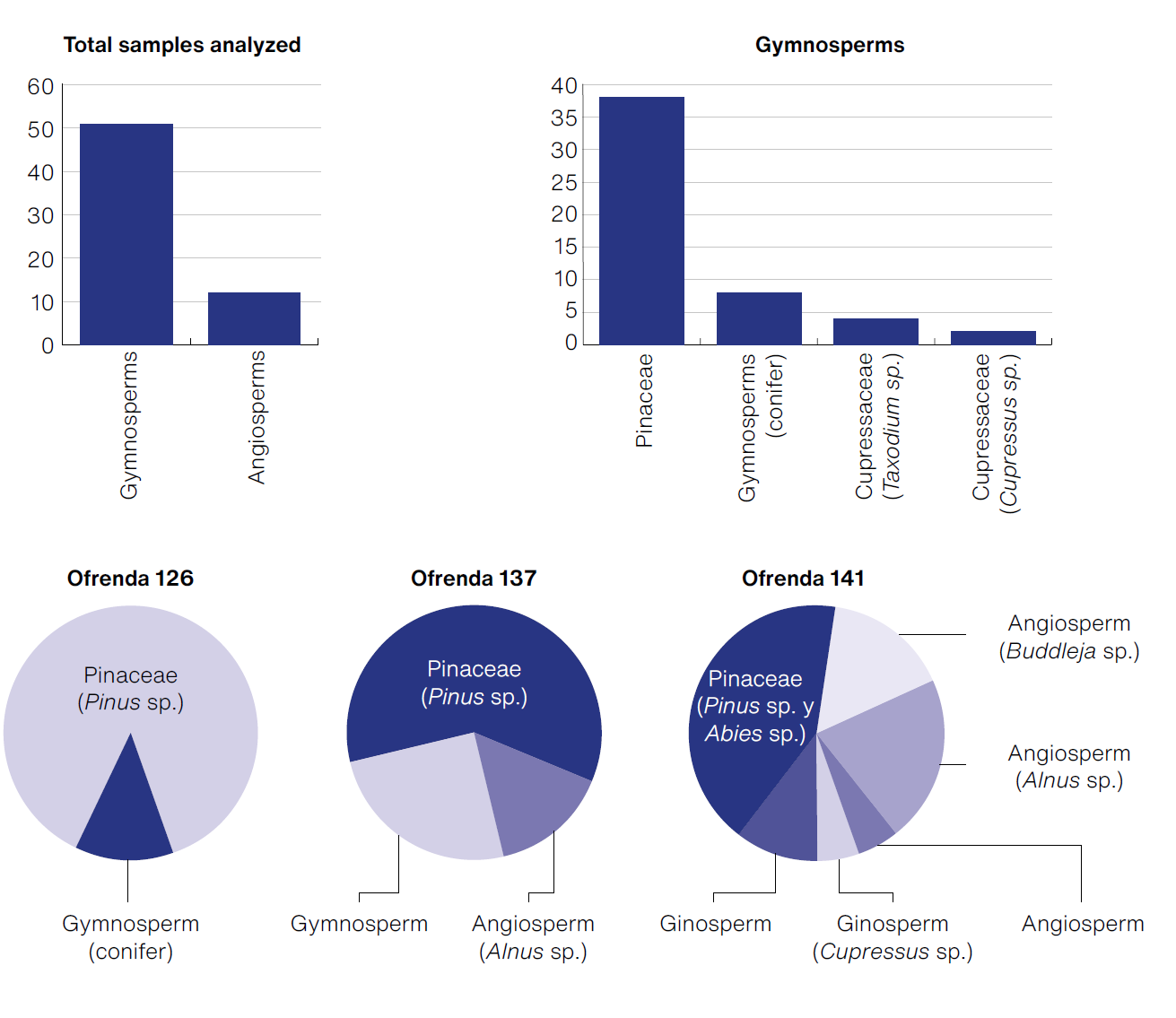
(Analysis: Conservation Team of the Proyecto Templo Mayor and Biology Lab [ENCRyM], 2021; courtesy: PTM-INAH)
Figure 9 Results obtained in the first group of samples. A predominance of conifers, mainly from the Pinaceae family, is observed.
It was equally interesting to review the information provided by the density values for the species analyzed. That value for (dry) wood as a raw material directly impacts, together with the other physical-mechanical properties, and is a reliable indicator of mechanical resistance (Bodiq, & Jane, in Sotomayor, 2005, p. 6). The data obtained indicated a choice of wood with medium densities in most of the samples, that is, those that would not only be resistant but also optimal for carving.
As for measuring the effectiveness of the stabilization process with synthetic sugars, the observations under the scanning electron microscope verified that the crystallization of sugars within the vegetal structures contributed to the thickening of the cell walls. This was noted with both methods of substitution, whereas in the samples subjected to controlled drying -with no sugar infiltration- weakening and fracturing in the vegetal structures were detected. The observations of the samples coincided, moreover, with regular inspections and monitoring carried out on the stabilized objects. Thus the collection’s stability has been confirmed for both the short and medium-term (Figure 10).
Figure 10 Infiltration process with synthetic sugars. Evaluation of results under scanning electron microscope
Table: Conservation Team of the Proyecto Templo Mayor, Biology Lab [ENCRyM] and Sub-directorate of Laboratories and Academic Support [INAH] 2016; courtesy: PTM-INAH).
Finally, the taxonomic identifications have led to certain observations regarding the species identified and their relationship with the established typologies. The entire array of samples obtained from different scepters (in the form of a bone, Techálotl, tlahuitímetl, serpentiform, deer head and chicahuaztli) were identified as gymnosperms (conifers), mainly from the Pinaceae family. This could be due to the ease in shaping such wood, which comes from correspondingly soft pines and has a medium density. One must not forget, however, that a large percentage of the 62 samples identified are from gymnosperms, chiefly from that same family: Pinaceae. Therefore, we must continue with the identification of more elements, in order to achieve a greater grasp of this domain.
The results and their relationship with the established typologies have also led to certain other questions being posed. A noteworthy case concerns the two Tlaloc masks from Ofrenda 141, which were determined to be Alnus sp. The analyses revealed that the nose on one of these masks (A 1221) was carved in a different manner to the rest of the mask, to be added later. Following the identification of the wood for the nose being Pinus ayacahuite, certain queries inevitably arose. It would be interesting to comprehend the reasons why different types of wood were used to assemble parts of the same element. Perhaps it was due to the availability of materials at the time it was created, to the artisan’s skills or to the differences in density and ease to carve each part. This research will continue to delve into these issues (Figure 11).
Conclusions
From the outset of the PTM, its specialists have always worked in a multidisciplinary manner. It can be stated that over more than 40 years of work, archaeology has been accompanied by conservation, and this research once again confirms this fact. Throughout this work the different disciplines have integrated and complemented each other, in order to obtain deeper knowledge about the wooden objects recently recovered in the Templo Mayor.
Thus, this multidisciplinary research demonstrates that such approaches to a set of cultural objects allow us to obtain information that will increase our knowledge and understanding of the case under study. Although the main objective established for the collaboration between the PTM and the Laboratorio de Biología at the ENCRyM was knowledge of the wood species in order to measure and evaluate their state of conservation and relationship with the stabilization process, the taxonomic identifications of this first phase have also enabled us to complement different approaches to the analysis of this unparalleled collection.
Studies will continue to advance and complement each other with the results obtained during subsequent phases of this research, in order to identify coincidences with regard to species, typologies, state of conservation, stabilization processes and specific characteristics of the context.
ACKNOWLEDGEMENTS
The first phase of this work benefited from the support of doctor Alejandra Quintanar Isaías, researcher at the Universidad Autónoma Metropolitana-Iztapalapa (UAM-I, Mexico) (Quintanar, 2013) and Cristina Adriano Morán, researcher at the Instituto de Investigaciones Antropológicas belonging to the Universidad Nacional Autónoma de México (IIA-UNAM). The taxonomic identifications carried out in the Laboratorio de Biología at the encrym were performed by L. Patricia Olvera Coronel. The sem observations were made with the assistance of engineer Mario Monroy, from the Subdirección de Laboratorios y Apoyo Académico, INAH.
REFERENCES
Alonso, A. (1996). Madera arqueológica anegada: una guía para su estudio y conservación [Tesis de licenciatura en Restauración de Bienes Muebles]. Escuela Nacional de Conservación, Restauración y Museografía-Instituto Nacional de Antropología e Historia. [ Links ]
Alonso, A. (2011). La conservación de bienes arqueológicos de madera. Arqueología Mexicana, 108, 56-60. [ Links ]
Alonso, A., Imazu, S., Mendoza-Anaya, D., Morgos. A, y Tzompantzi-Reyes. M. T. (22 al 27 de septiembre de 2002). The lactitol conservation of wet polychrome wooden objects found in a 15th-century Aztec archaeological site in México [Presentación en conferencia]. icom Committee for Conservation 13th Triennial Meeting, Río de Janeiro. [ Links ]
Alonso, A. y Tran, K. (2010). Nueva tecnología aplicada a la restauración y estudio de una escultura arqueológica de madera. Instituto Nacional de Antropología e Historia (Colección Científica). [ Links ]
Barajas, M., Sanromán, A., Hernández, K. V. y Mancilla, M. (2019). La conservación y el análisis de la madera arqueológica en el Proyecto Templo Mayor. En L. López Luján y X. Chávez Balderas (Coords.), Al pie del Templo Mayor. Estudios en honor de Eduardo Matos Moctezuma (pp. 339-362). El Colegio Nacional. [ Links ]
Conabio. (2020). Biodiversidad mexicana. Vecinos verdes. Aile, Aliso, Hilit. Alnus acuminata subsp. arguta. Comisión Nacional para el Conocimiento y Uso de la Biodiversidad. http://www.conabio.gob.mx/conocimiento/info_especies/arboles/doctoss/9-betul1m.pdf [ Links ]
Conafor. (2020). sire-Paquete tecnológico. Serie Maderas de México. Pinus ayacahuite. Comisión Nacional Forestal. http://www.conafor.gob.mx:8080/documentos/docs/13/953Pinus%20ayacahuite.pdf [ Links ]
Cruz, G. (2015). Identificación de materiales inorgánicos arqueológicos provenientes del Templo Mayor. Informe técnico del Laboratorio de Biología de la ENCRyM entregado al Proyecto Templo Mayor del INAH. [ Links ]
De la Paz, C., Olvera, L. P. y Corral, G. (1982). Estudio anatómico de la madera de 26 especies de angiospermas de clima templado. Boletín Técnico de la Secretaría de Agricultura y Recursos Hidráulicos (91). [ Links ]
García, L., Guindeo, A., Peraza, C. y De Palacios, P. (2003). La madera y su anatomía. Anomalías y defectos, estructura microscópica de coníferas y frondosas, identificación de maderas, descripción de especies y pared celular. Fundación Conde del Valle de Salazar/Ediciones Mundiprensa/AiTim. [ Links ]
IAWA Committee. (1989). IAWA List of microscopic features for hardwood identification. IAWA Bulletin, 10(3), 219-332. [ Links ]
Inegi. (2021). Continuo Nacional Topográfico. Instituto Nacional de Estadística y Geografía. http://cuentame.inegi.org.mx/monografias/informacion/df/territorio/relieve.aspx?tema=me&e=09 [ Links ]
López, L. (1993). Las ofrendas del Templo Mayor de Tenochtitlan. Instituto Nacional de Antropología e Historia. [ Links ]
López, L. (2014). El Proyecto Templo Mayor (2007-2014). Arqueología Mexicana, El Templo Mayor. A un siglo de su descubrimiento, ed. esp. (56), 76-78, 86-69. [ Links ]
López, L., Torres, J. y Montúfar, A. (2003). Los materiales constructivos del Templo Mayor de Tenochtitlan. Estudios de Cultura Náhuatl, 34, 137-166. [ Links ]
MAE y FAO. (2014). Propiedades anatómicas, físicas y mecánicas de 93 especies forestales. Ministerio del Ambiente del Ecuador/Organización de las Naciones Unidas para la Alimentación y la Agricultura. [ Links ]
Montúfar, A. (1999). Estudio arqueobotánico del subsuelo. En E. Matos (Coord.)., Excavaciones en la Catedral y el Sagrario Metropolitanos (pp. 111-115). Programa de Arqueología Urbana-Instituto Nacional de Antropología e Historia (Colección Obra Diversa). [ Links ]
Morgos, A., Imazu, S. e Ito, K. (2008). A summary and evaluation of 15 years research, practice and experience with Lactitol Methods developed for the conservation of waterlogged, degraded archaeological wood. En ICOM, 15th Triennal Conference [Actas de conferencia] (pp. 1074-1081). Allied Publishers. [ Links ]
Morgos, A., Imazu, S. e Ito, K. (2015). Sugar conservation of waterlogged archaeological finds in the last 30 years. En Condition.2015.Conservation and Digitalization (pp. 15-21). National Maritime Museum. [ Links ]
Nabors, M. (2006). Introducción a la botánica. Pearson Educación. [ Links ]
Ordóñez, J. A. B., Galicia, N., Venegas, N. J., Hernández, T., Ordóñez, M. de J. y Dávalos-Sotelo, R. (2015). Densidad de las maderas mexicanas por tipo de vegetación con base en la clasificación de J. Rzedowski: compilación. Madera y Bosques, 21, 77-126. [ Links ]
Quintanar, A. (2013). Identificación de la madera de piezas provenientes de la Ofrenda 141 del Proyecto Templo Mayor. Informe técnico del Laboratorio de Anatomía y Tecnología de la Madera de la UAM-I entregado al Proyecto Templo Mayor del INAH. [ Links ]
Rzedowski, J. (2006). Vegetación de México (ed. digital). Comisión Nacional para el Conocimiento y Uso de la Biodiversidad. [ Links ]
Sahagún, B. de. (1979). Códice Florentino. Manuscrito 218-20 de la Colección Palatina de la Biblioteca Medicea Laurenziana (ed. FACS. 3). Archivo General de la Nación/Secretaría de Gobernación. [ Links ]
Sánchez-González, A. (2008). Una visión actual de la diversidad y distribución de los pinos de México. Estado del Arte. Madera y Bosques , 14(1), 107-120. [ Links ]
Sánchez, G. M., Alonso, A. y Escalante, M. F. (2017). Estudio comparativo de sistemas de consolidación y flexibilización (almidón-PEG, quitina-PEG y lactitol-PEG) para la conservación de objetos de fibras duras provenientes de contextos arqueológicos secos y húmedos en México. Intervención, 8(15), 5-22. [ Links ]
Sandoval, E. (2005). Técnicas aplicadas al estudio de la anatomía vegetal. Universidad Nacional Autónoma de México (Cuadernos del Instituto de Biología, 38). [ Links ]
Sierra, J. L. (2003). La conservación de la madera arqueológica subacuática. Museo y Centro Nacional de Investigaciones Arqueológicas Submarinas. Monte Buciero (9), 225-266. [ Links ]
Sotomayor, J. R. (junio, 2005). Características mecánicas y clasificación de la madera de 150 especies mexicanas. Investigación e Ingeniería de la Madera, 1(1), 1-24. [ Links ]
Unger, A., Schniewind, A. y Unger, W. (2001). Conservation of Wood Artifacts. A Handbook. Library of Congress. [ Links ]
Received: June 12, 2021; Accepted: December 05, 2021; Published: December 28, 2021











 texto em
texto em 




















